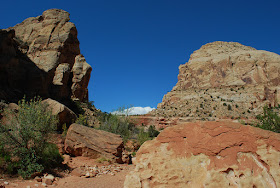The Trail
This difficult trail is 4.9 miles long (one way) with a 1613 foot elevation change. However, keep in mind that there is some up and down in the trail (see the elevation profile below). This trail shares a trail head with the
Hickman Bridge Trail. The trail splits about .3 mile up from the trail head (marked with a blue flag on the topographical map below). To just do the Navajo Knobs trail, stay to the right. For those who want to hike the Hickman Bridge Trail as a side trip too, your round trip hike will be about 11 miles long.
 |
| Topographical Map |
 |
| Graph of Elevation |
 |
| Trail in Google Earth |
This trail is very exposed with no shade, making it a hot, dry trip,
especially during the summer. Make sure you bring ample water with you
and cover up and/or wear plenty of sunscreen. However, hikers are
rewarded for their efforts with some spectacular views. There are also a lot of cool rock formations along the trail that add additional interest along the way.
 |
| Pectols Pyramid |
It is important to stay on the trail and off the dirt so as not to disturb the cryptobiotic crust. The trail is easy to follow. Where dirt paths disappear on the rocks, rock cairns are easy to spot marking the way.
 |
This rock cairn is made with a log of petrified
wood at its base |
There are actually three specific viewpoints found along the trail. The first is a view of the Hickman Bridge. Hikers will get a much better view of this natural bridge from the Hickman Bridge Trail since it is partially obscured from this view point.
 |
| Hickman Bridge from viewpoint |
The second viewpoint is the Rim Overlook (marked by the green flag on the topographical map). From here hikers get a great view of Fruita below and the canyons surrounding the historic settlement.
 |
| View from Rim Overlook |
 |
| Another view from Rim Overlook |
 |
| The fruit trees growing in Fruita |
 |
| From Rim Overlook |
From the Rim Overlook, the trail heads northward for a ways immediately to the east of The Castle. Then toward the latter end, the trail heads more westward as it winds up and down a couple jutting rims before ascending to its finish next to the Navajo Knobs.
 |
| The Castle |
 |
| The Castle |
The last portions of the trail involve hiking up and down some slickrock fields along the canyon rims.
 |
| Climbing up the slickrock
|
 |
| Looking back at one of the rims the trail follows up and then back down |
 |
| Right before reaching the top hikers see this little arch |
The views from the end of the trail are fantastic! Hikers can see canyons, mountains, rocks, and valleys for miles around. The pictures just can't do it justice.
 |
| View from the top looking southeast
|
 |
| View from the top looking northwest |
 |
| Looking back at Navajo Knobs (circled) from across the way |
Directions
This trail is located in Capitol Reef National Park in Wayne County,
Utah. The trail is right off UT-24. To get there from I-15, take Exit
188 to get onto US-50. Get off US-50 at UT-260. From there get onto
UT-24 and continue to Capitol Reef and the trail head, which will be on the left.


















































